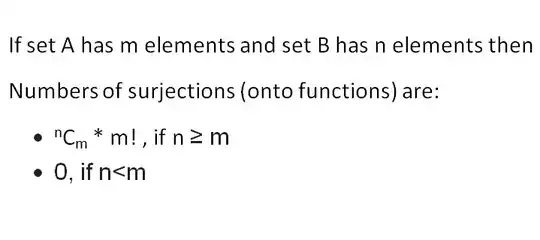How many functions from set $\{1,2,3,\ldots,n\}$ to $\{A,B,C\}$ are surjections? $n \geq 3$
Attempt
I was hoping to count the number of surjections by treating $A,B,C$ like bins, and counting the number of ways to fill them with $1,2,3,\ldots,n$ such that no bins are empty. This is equivalent to putting two "separator" bars in between the $n$ numbers or $n-1 \choose 2$.
However, I think I am missing a step here: prior to putting in the separator bars, I should permutate the $n$ elements. So, multiply by $n!$.
The order of elements in the same bins do not matter. So I should be divided by the number of permutations of the elements in each bins. This is where I am stuck.
Additional Info
I made the question up myself. Feel free to modify the question into a more solvable form if it is too difficult/complicated.

